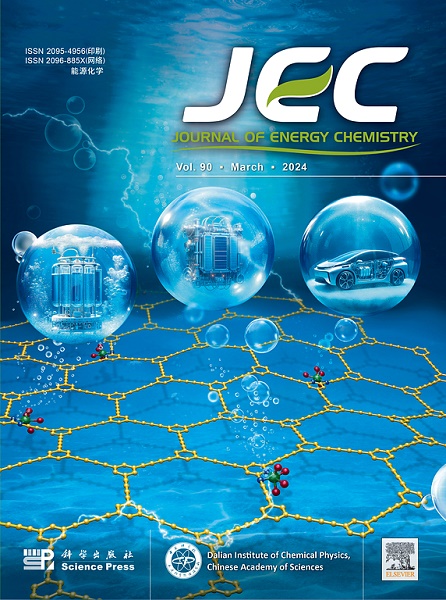通过增强动力学-机械特性缓解富镍阴极的快速充电降解现象
IF 13.1
1区 化学
Q1 Energy
引用次数: 0
摘要
富镍正极材料对于提高电动汽车(EV)中锂离子电池(LIB)的性能至关重要,尤其是在极端快速充电(XFC)和耐用性方面。虽然许多研究都聚焦于在阳极上镀锂以提高速率能力,但在 XFC 条件下将动力学改进与阴极材料的机械强度相结合的研究却非常缺乏。在这项工作中,成功合成了镁/钛共掺杂富镍 LiNi0.88Co0.09Mn0.03O2 (MT-NCM),以应对与高速率循环相关的结构挑战。结果表明,更强的 Ti-O 键有助于增强二次晶粒的机械强度,从而有效缓解快速充电过程中微裂纹的形成。此外,由于双掺杂剂的协同作用,MT-NCM 的有害相变、内部应变以及寄生反应都得到了显著抑制,从而确保了与原始 NCM(P-NCM)相比出色的锂离子传输动力学性能。因此,MT-NCM 实现了卓越的高速循环性能,在 5 C 时保持了 88.04% 的初始容量,即使在 10 C 时也能保持超过 175 mA h g-1 的卓越放电容量。这项工作凸显了优化富镍阴极动力学-机械特性的潜力,为开发具有更高耐久性的 XFC LIBs 提供了一种可行的方法,可用于电动汽车应用。本文章由计算机程序翻译,如有差异,请以英文原文为准。

Mitigating fast-charging degradation in Ni-rich cathodes via enhancing kinetic-mechanical properties
Ni-rich cathode materials are essential for enhancing the performance of lithium-ion batteries (LIBs) in electric vehicles (EVs), particularly concerning extreme fast charging (XFC) and durability. While much of studies shine a spotlight on Li plating on the anode to improve rate capability, there is a critical lack of studies addressing the combination of kinetic improvements and mechanical strength of cathode materials under XFC conditions. In this work, Mg/Ti co-doped Ni-rich LiNi0.88Co0.09Mn0.03O2 (MT-NCM) was successfully synthesized to address structural challenges associated with high-rate cycling. The results demonstrate that the stronger Ti–O bond contributes to the enhanced mechanical strength of secondary grains, which effectively alleviates microcrack formation during fast charging. Additionally, the detrimental phase transitions and internal strain as well as parasitic reactions of MT-NCM are significantly suppressed due to the synergistic effect of the dual dopants, ensuring excellent Li-ion transport kinetics compared to pristine NCM (P-NCM). Consequently, MT-NCM achieves remarkable high-rate cycling performance, retaining 88.04% of its initial capacity at 5 C and superior discharge capacity over 175 mA h g−1 even at 10 C. This work highlights the potential of optimizing the kinetic-mechanical properties of Ni-rich cathodes, providing a viable approach for the development of XFC LIBs with improved durability for EV applications.
求助全文
通过发布文献求助,成功后即可免费获取论文全文。
去求助
来源期刊

Journal of Energy Chemistry
CHEMISTRY, APPLIED-CHEMISTRY, PHYSICAL
CiteScore
19.10
自引率
8.40%
发文量
3631
审稿时长
15 days
期刊介绍:
The Journal of Energy Chemistry, the official publication of Science Press and the Dalian Institute of Chemical Physics, Chinese Academy of Sciences, serves as a platform for reporting creative research and innovative applications in energy chemistry. It mainly reports on creative researches and innovative applications of chemical conversions of fossil energy, carbon dioxide, electrochemical energy and hydrogen energy, as well as the conversions of biomass and solar energy related with chemical issues to promote academic exchanges in the field of energy chemistry and to accelerate the exploration, research and development of energy science and technologies.
This journal focuses on original research papers covering various topics within energy chemistry worldwide, including:
Optimized utilization of fossil energy
Hydrogen energy
Conversion and storage of electrochemical energy
Capture, storage, and chemical conversion of carbon dioxide
Materials and nanotechnologies for energy conversion and storage
Chemistry in biomass conversion
Chemistry in the utilization of solar energy
 求助内容:
求助内容: 应助结果提醒方式:
应助结果提醒方式:


